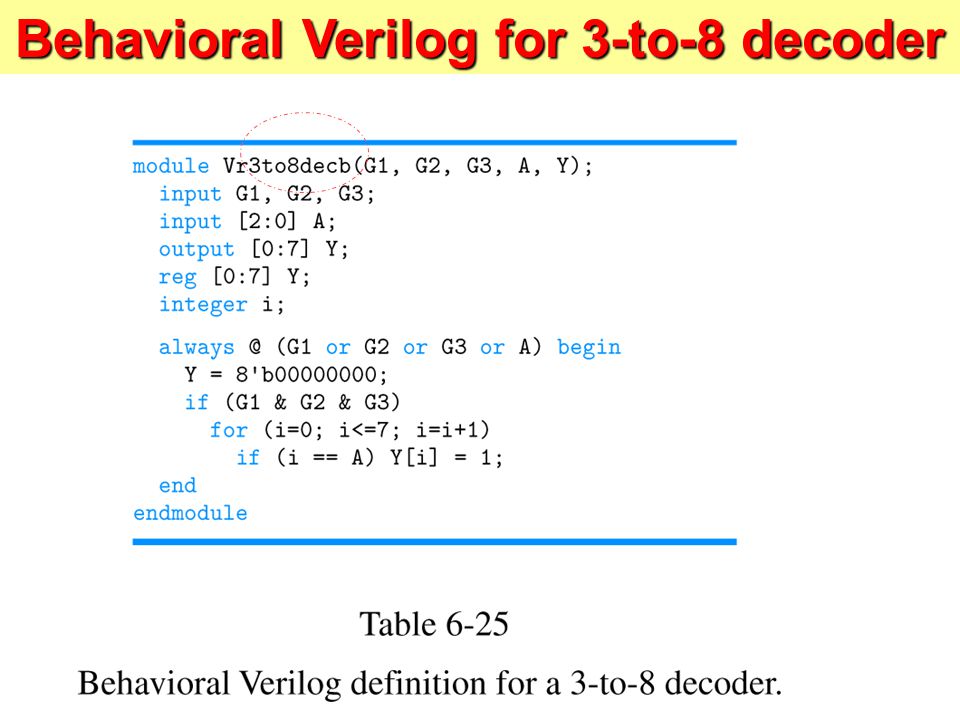Behavioral Systemverilog Module For 4-to-1 Decoder
Behavioral Description of 2 to 4 Decoder module dec2x4(xin,yout,enable); input 1:0 xin; input enable; output3:0 yout; reg3:0 yout; always @(xin or enable). The following '.pdf' files are examples of the ways basic combinational / sequential circuits can be modeled using Verilog HDL. Associated with each logic module is a Verilog test bench module that instantiates the appropriate module and provides some stimulus to the inputs so that the outputs can be verified. Project 5: Multiplexer, Decoder, Encoder, and Shifter: In this project you will design a multiplexer, a decoder, an encoder, and a shifter using Verilog HDL. Instead of building the circuit using.
- 4 To 1 Multiplexer Using Behavioral Verilog Code
- Behavioral Systemverilog Module For 4-to-1 Decoder 2
This is all generally covered by Section 23.3.2 of.The simplest way is to instantiate in the main section of top, creating a named instance and wiring the ports up in order: module top(input clk,input rstn,input enable,input 9:0 datarx1,input 9:0 datarx2,output 9:0 datatx2);subcomponent subcomponentinstancename (clk, rstn, datarx1, datatx );endmoduleThis is described in Section 23.3.2.1 of.This has a few draw backs especially regarding the port order of the subcomponent code. Simple refactoring here can break connectivity or change behaviour. For example if some one else fixs a bug and reorders the ports for some reason, switching the clk and reset order. There will be no connectivity issue from your compiler but will not work as intended. Module subcomponent(input rstn,input clk.It is therefore recommended to connect using named ports, this also helps tracing connectivity of wires in the code. Module top(input clk,input rstn,input enable,input 9:0 datarx1,input 9:0 datarx2,output 9:0 datatx2);subcomponent subcomponentinstancename (.clk(clk),.rstn(rstn),.datarx(datarx1),.datatx(datatx) );endmoduleThis is described in Section 23.3.2.2 of.Giving each port its own line and indenting correctly adds to the readability and code quality. Subcomponent subcomponentinstancename (.clk ( clk ), // input.rstn ( rstn ), // input.datarx ( datarx1 ), // input 9:0.datatx ( datatx ) // output 9:0);So far all the connections that have been made have reused inputs and output to the sub module and no connectivity wires have been created.

What happens if we are to take outputs from one component to another: clkgen(.clk ( clksub ), // output.en ( enable ) // inputsubcomponent subcomponentinstancename (.clk ( clksub ), // input.rstn ( rstn ), // input.datarx ( datarx1 ), // input 9:0.datatx ( datatx ) // output 9:0);This nominally works as a wire for clksub is automatically created, there is a danger to relying on this. How to change recycle bin icon. It will only ever create a 1 bit wire by default. An example where this is a problem would be for the data:Note that the instance name for the second component has been changed subcomponent subcomponentinstancename (.clk ( clksub ), // input.rstn ( rstn ), // input.datarx ( datarx1 ), // input 9:0.datatx ( datatemp ) // output 9:0);subcomponent subcomponentinstancename2 (.clk ( clksub ), // input.rstn ( rstn ), // input.datarx ( datatemp ), // input 9:0.datatx ( datatx ) // output 9:0);The issue with the above code is that datatemp is only 1 bit wide, there would be a compile warning about port width mismatch. The connectivity wire needs to be created and a width specified. I would recommend that all connectivity wires be explicitly written out.
4 To 1 Multiplexer Using Behavioral Verilog Code
Wire 9:0 datatempsubcomponent subcomponentinstancename (.clk ( clksub ), // input.rstn ( rstn ), // input.datarx ( datarx1 ), // input 9:0.datatx ( datatemp ) // output 9:0);subcomponent subcomponentinstancename2 (.clk ( clksub ), // input.rstn ( rstn ), // input.datarx ( datatemp ), // input 9:0.datatx ( datatx ) // output 9:0);Moving to SystemVerilog there are a few tricks available that save typing a handful of characters. I believe that they hinder the code readability and can make it harder to find bugs.Use.port with no brackets to connect to a wire/reg of the same name. This can look neat especially with lots of clk and resets but at some levels you may generate different clocks or resets or you actually do not want to connect to the signal of the same name but a modified one and this can lead to wiring bugs that are not obvious to the eye. Module top(input clk,input rstn,input enable,input 9:0 datarx1,input 9:0 datarx2,output 9:0 datatx2);subcomponent subcomponentinstancename (.clk, // input.Auto connect.rstn, // input.Auto connect.datarx ( datarx1 ), // input 9:0.datatx ( datatx ) // output 9:0);endmoduleThis is described in Section 23.3.2.3 of.Another trick that I think is even worse than the one above is. which connects unmentioned ports to signals of the same wire. I consider this to be quite dangerous in production code.
It is not obvious when new ports have been added and are missing or that they might accidentally get connected if the new port name had a counter part in the instancing level, they get auto connected and no warning would be generated. Subcomponent subcomponentinstancename (., //.Auto connect.datarx ( datarx1 ), // input 9:0.datatx ( datatx ) // output 9:0);This is described in Section 23.3.2.4 of. Be sure to check out verilog-mode and especially verilog-auto. It is a verilog mode for emacs, but plugins exist for vi(m?) for example.An instantiation can be automated with AUTOINST. The comment is expanded with M-x verilog-auto and can afterwards be manually edited. Subcomponent subcomponentinstancename(/.AUTOINST./);Expanded subcomponent subcomponentinstancename (/.AUTOINST.///Inputs.clk, (clk).rstn, (rstn).datarx (datarx19:0),//Outputs.datatx (datatx9:0));Implicit wires can be automated with /.AUTOWIRE./.
Behavioral Systemverilog Module For 4-to-1 Decoder 2
Check the link for further information.